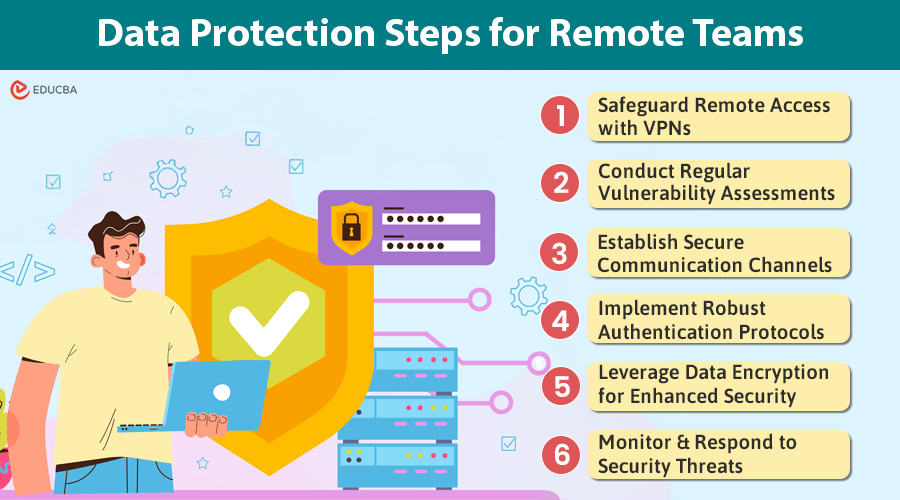Introduction to Data Protection Steps for Remote Teams
With remote work becoming the norm, protecting sensitive data is more critical than ever. Securing company information is challenging as traditional office spaces give way to virtual work environments. However, there are practical steps that businesses can take to enhance data security. Let us look at the actionable data protection steps for remote teams and why they work.
Data Protection Steps for Remote Teams
Here are the data protection steps for remote teams:
#1. Safeguard Remote Access with VPNs
A Virtual Private Network (VPN) is the first line of defense for protecting your remote team’s data. VPNs ensure remote workers access corporate networks securely, regardless of location.
A VPN can:
- Encrypt data traffic, keeping information confidential
- Mask IP addresses, providing privacy for users
- Bypass geographical restrictions for seamless access.
These advantages are important for securing digital assets and increasing the convenience of remote working setups, so it is doubly worth adopting a VPN.
For best results:
- Choose a trusted provider with strong encryption protocols
- Ensure compatibility across devices and operating systems
- Keep the software updated and patched to avoid security risks.
#2. Conduct Regular Vulnerability Assessments
Routine assessments keep you ahead of potential threats by identifying weaknesses before attackers exploit them.
Regular checks provide:
- Insight into existing security gaps
- A proactive approach to threat mitigation
- Opportunities to reinforce security measures.
By keeping tabs on CVE trends alternative approaches can be evaluated, which often leads to discovering new vulnerabilities that might not have been obvious initially.
To conduct effective vulnerability assessments:
- Use automated tools for quick and efficient scanning
- Include both internal and external systems in your audits
- Review assessment reports thoroughly, implementing necessary fixes promptly.
#3. Establish Secure Communication Channels
For remote teams, securing communication is essential to protect sensitive information exchanged daily.
Secure channels offer:
- Encrypted messaging and calls for privacy
- Assurance that only authorized users access conversations
- Protection against interception by malicious entities.
When working on this approach:
- Opt for reputable platforms with end-to-end encryption capabilities
- Regularly update software to guard against new vulnerabilities
- Teach team members to use only approved communication channels.
#4. Implement Robust Authentication Protocols
Strong authentication is vital for confirming the identity of users accessing sensitive systems. This added layer deters unauthorized access, enhancing overall security. With more than 1 billion digital records stolen so far this year, organizations have no choice but to take this seriously.
Effective protocols provide:
- Verification through multiple factors, like passwords and biometrics
- Reduced risk of credential theft
- Greater control over user access to critical resources.
To strengthen your authentication process:
- Use two-factor or multi-factor authentication methods whenever possible
- Regularly update and require complex passwords from all users
- Limit permissions based on job roles, ensuring only necessary data is accessible
#5. Leverage Data Encryption for Enhanced Security
Encrypting data converts it into a coded format, accessible only by those with the decryption key. This ensures information remains secure, even if intercepted.
Effective encryption:
- Safeguards sensitive data during storage and transmission
- Provides compliance with regulatory standards
- Minimizes the impact of potential breaches.
To leverage encryption effectively:
- Encrypt all sensitive files before sharing them externally or storing them in cloud services
- Utilize full-disk encryption on devices to protect against physical theft or loss
- Regularly update cryptographic protocols to defend against evolving threats.
#6. Monitor and Respond to Security Threats
Constant network monitoring helps identify and address threats swiftly, minimizing potential damage, which can cost almost $10 million on average to repair. A proactive response system is crucial for maintaining security integrity.
Key benefits include:
- Early detection of unusual activities
- Immediate action plans for threat mitigation
- Enhanced ability to prevent future attacks.
To improve threat management:
- Implement real-time network monitoring tools for continuous oversight
- Create a clear incident response plan that covers every step, from identifying the issue to resolving it
- Regularly update response strategies based on lessons learned from past incidents.
Final Thoughts
Securing data for remote teams requires a multifaceted approach, as relying solely on existing security measures is no longer enough due to the constant emergence of new threats. By implementing these data protection steps for remote teams, businesses can safeguard sensitive information, reduce risks, and enhance productivity. This involves investing in tools like VPNs, encryption, and strong authentication protocols, regularly assessing vulnerabilities, and continuously updating strategies. Educating your team and prioritizing security within your remote work environment ensures that your teams remain secure, resilient, and productive in the ever-evolving digital landscape.
Recommended Articles
We hope this guide on data protection steps for remote teams has been helpful. Check out these recommended articles for more tips on securing your remote work environment and boosting productivity.



